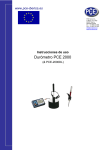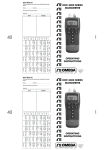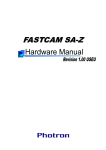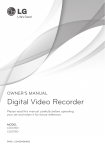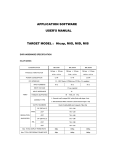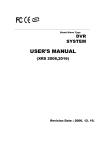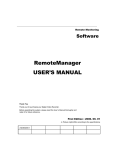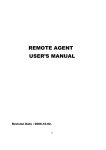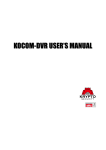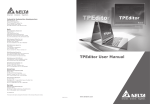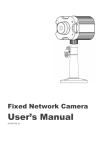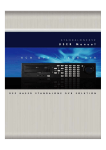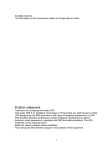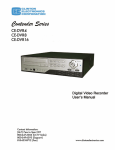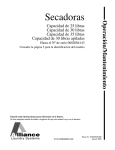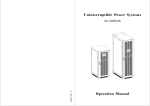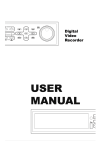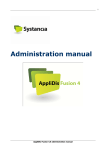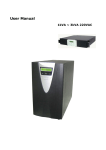Download DiSS NM-1000/2000/3000 User Manual
Transcript
DiSS NetMaster NM-1000/2000 Series NM-1004/1008 NM-2004DL/2008DL/2016DL User Manual ※ The picture might differ according to the specifications. ©1997-2004 Sungjin C&C Contents of this user manual and NM-2016DL software are protected under copyrights and computer program laws. st First Edition June 1 , 2004. rd 3 Floor, B-dong, SKTwinTechTower, 345-9, Kasan-dong, Geumcheon-gu, Seoul 153-802, Korea SungJin C&C Customer Service: TEL : 02-2007-6327, 080-599-8272 FAX : 02-2007-6330 Thank You Thank you for purchasing SungJin C&C’s DiSS, Digital Security System. Before operating the system, please read this User’s Manual thoroughly and retain it for future reference. Warning Electric Safety To reduce a risk of fire or electrical shock. Do not expose this product to rain or moisture. Caution Lithium Battery Danger of explosion if battery is incorrectly replaced. Replace only with the same or equivalent type recommended by the manufacturer. Dispose of used batteries according to the manufacturer’s instructions. Cautions Must follow these details to prevent material damage beforehand. Signs of Caution and Warning Warning: This sign indicates that the user could die or wounded seriously if not used or installed properly. Caution: This sign indicates that the user could be wounded or could expect property damage if not used or installed properly. Electric Safety Warning To reduce a risk of fire or electrical shock. Do not expose this product to rain or moisture. Cautions about lithium battery Warning 1. Change the battery after turning the power off of the product. 2. Connect the polarity of the lithium properly while changing. 3. Change with the same type of battery recommended by the product manufacturer. 4. Follow the instruction from battery manufacturer to change the battery. There is danger of explosion when the instruction is not followed. Important Safeguards Warning 1. Use the power cord, which is supplied or recommended by the supplier. It may be cause of fire. 2. Do not dismantle or assemble the product. It may cause malfunction or fire. 3. Do not touch the product with wet hands. It may become a reason for malfunction or fire. 4. Matters must be ensured to a professional to install the product. It may become a reason for malfunction, electric shock or fire. 5. Inquire from the place of purchase if the need for installation in distinct place arises. Delinquent installation may be the reason for malfunction, electric shock or fire. 6. Ground applies to video products equipped with a 3-wire grounding type plug having a third (grounding) pin. This plug only fits into a grounding-type power outlet. If grounding is not done, it may cause break down or electric shock. 7. Ground connection must not touch gas pipe, water pipe or telephone line. If grounding is not done properly, it may cause electric shock. 8. Prevent metallic foreign substance from going inside the product. It may become a reason for malfunction or electric shock. 9. Do not spray insecticide or flammable spray while driving. It may be cause for fire. 10. Prevent water from entering inside electrical parts. Clean with a dry tower or it may become a reason for malfunction or electric shock. Caution 1. Use the power cord, which is supplied or recommended by the supplier. The internal fan rotates in high speed and it may become a reason for accident. 2. Do not drop; give strong vibration or shock to the product. It may become a reason for malfunction. 3. The air inhaler of the front panel and air outlet of the back panel must not be blocked while installing. The internal temperature of the product would be more than what is allowed and it may become a reason for malfunction or would generate heat. 4. Do not touch the product or the power cord when there is thunder. It may become a reason for electric shock. 5. Do not install the product near or on top of heating system. The internal temperature of the product would be more than what is allowed and it may become a reason for malfunction or would generate heat. 6. Do not install the product on inclined or unstable location and where vibration could be committed. It may become a reason for malfunction. Cautions about the Power Warning 1. Must use the outlet of the grounding to connect the power cord. It may become a reason for fire. 2. Do not connect on the middle of power cord or use extension cord. It may generate heat or cause fire. 3. Do not touch the power cord with wet hands. It may become a reason for electric shock 4. Prevent wetting the power cord by humidity. It may generate heat or cause fire. The power cord is not waterproof. 5. Hold the body of the plug while pulling off the power plug. Do not pull the power line as part of the power line would be cut off and it may generate heat or cause fire. 6. Check the power plug regularly. By humidity and moderation in smoking, it may cause fire. 7. Pull of the power cord from the outlet when the product is not used for a long time. It may become a reason for short-circuit or electric shock. Caution 1. Do not turn of the power by pulling the power plug out. To turn off the power, click the power button from the front panel. When the system stop abnormally the power button might not work, then click the power button for at least 4 seconds to turn off the power. 2. Do not cut off the power artificially, give shock or vibration while the hard disk is activating. It may become a reason for hard disk failure or loss of data. Table of Contents 1. SYSTEM STRUCTURE........................................................................................................................................................................ 1 1.1 1.2 2. System Configuration ........................................................................................................................................................................ 3 2.1 2.2 2.3 2.4 3. 4. Camera Setting........................................................................................................................................................................... 20 Network....................................................................................................................................................................................... 23 Sensor ........................................................................................................................................................................................ 26 Camera Control .......................................................................................................................................................................... 28 Video Input Signal Adjustment.................................................................................................................................................... 32 Select Recording ........................................................................................................................................................................ 33 Frame Rate Adjustment.............................................................................................................................................................. 37 Recording Schedule ................................................................................................................................................................... 38 Extra Setting ............................................................................................................................................................................... 41 VIEWER.............................................................................................................................................................................................. 44 6.1 6.2 6.3 6.4 6.5 6.6 Basic Operations ........................................................................................................................................................................ 44 Screen Layout............................................................................................................................................................................. 45 Detail Functions .......................................................................................................................................................................... 46 Other Setting............................................................................................................................................................................... 52 Smart Search (NM-2000DL Series)............................................................................................................................................ 54 APP (NM-2000DL Series)........................................................................................................................................................... 58 SPECIFICATION ................................................................................................................................................................................ 63 7.1 7.2 8. System Operations ..................................................................................................................................................................... 13 Screen Layout............................................................................................................................................................................. 14 Detail Functions .......................................................................................................................................................................... 15 SETTING CUSTOMIZED FUNCTIONS ............................................................................................................................................. 20 5.1 5.2 5.3 5.4 5.5 5.6 5.7 5.8 5.9 7. NM-1000 Series Installation ......................................................................................................................................................... 7 NM-2000DL Series Installation................................................................................................................................................... 10 OPERATIONS OF NetMaster ....................................................................................................................................................... 13 4.1 4.2 4.3 6. NM-1000 Series Front Panel ........................................................................................................................................................ 3 NM-2000DL Series Front Panel ................................................................................................................................................... 4 NM-1000 Series Back Panel ........................................................................................................................................................ 5 NM-2000DL Series Back Panel.................................................................................................................................................... 6 INSTALLATION.................................................................................................................................................................................... 7 3.1 3.2 5. NM-1000 Series............................................................................................................................................................................ 1 NM-2000DL Series ....................................................................................................................................................................... 2 NM-1000 Series.......................................................................................................................................................................... 63 NM-2000DL Series ..................................................................................................................................................................... 64 APPENDIX ......................................................................................................................................................................................... 65 8.1 8.2 Pin Assignment of Alarm Port..................................................................................................................................................... 65 TCP/IP Port Setting Method using the firewall. .......................................................................................................................... 66 1 1. SYSTEM STRUCTURE The following components are supplied with the NetMaster series. Check your NetMaster system and its accessories are securely packed. As you unpack your system, please be sure to check all of the following items are included. Carefully inspect each component to make sure nothing is missing or damaged. When any of these items is missing or damaged, notify your dealer immediately. Keep the packing utilities for moving or storage purposes afterwards. 1.1 NM-1000 Series Qty Contents 1 User Manual 1 DiSS RemoteAgent CD 1 Power Cord 1 Rubber Mount 1 Mouse 2 1.2 NM-2000DL Series Qty Contents 1 User Manual 1 Power Cord 1 Mouse 1 D-sub Connector 1 DiSS RemoteAgent CD 1 4/8CH BNC-to-D-sub Cable (Select by Max Channel Number) 3 2. System Configuration 2.1 NM-1000 Series Front Panel NM-1004/1008 No. Functions No. 1 Power Button 4 Functions USB Port 2 Power LED 5 CD-RW / DVD-RAM (Option) 3 HDD LED 2.1.1. Power Button Press the power button after connecting power cord. 2.1.2. Power LED Shows the power is on. 2.1.3. HDD LED Shows data is either being read or written in HDD. 2.1.4. USB Port This internal USB port is used to connect the USB to the system. USB port is composed in back panel of the system also. 2.1.5. CD-RW / DVD-RAM (Option) It is possible to mount CD-RW / DVD-RAM as backup or removable HDD as data storage. 4 2.2 NM-2000DL Series Front Panel NM-2004DL/2008DL/2016DL No. Functions No. Functions 1 Power Button 4 USB Port 2 Power LED 5 CD-RW / DVD-RAM (Option) 3 HDD LED 2.2.1. Power Button Press the power button after connecting power cord. 2.2.2. Power LED Shows the power is on. 2.2.3. HDD LED Shows data is either being read or written in HDD. 2.2.4. USB Port This internal USB port is used to connect the USB to the system. USB port is composed in back panel of the system also. 2.2.5. CD-RW / DVD-RAM (Option) It is possible to mount CD-RW / DVD-RAM as backup or removable HDD as data storage. 5 2.3 NM-1000 Series Back Panel Note Composition differs according to system model. (NM-1004/1008) No. 1 2 Functions Power Connection Circuit Mouse Port No. 8 9 Functions LAN Port Mic input 3 Keyboard Port 10 Speaker Output 4 PTZ Controller Port 11 Spot Monitor Output (BNC Jack) 5 6 Printer Port PC Monitor Output 12 13 Camera Image Input (BNC Jack) Sensor / Alarm Connection 7 USB Port 6 2.4 NM-2000DL Series Back Panel Note Composition differs according to system model. (NM-2004DL/2008DL/2016DL) No. Functions No. Functions 1 2 Power Selection Switch Power Connection Circuit 9 10 LAN Port Speaker Output 3 Mouse Port 11 Mic Input 4 Keyboard Port 12 Alarm Input/Output Port 5 6 USB Port PTZ Controller Port / RS-232C (COM1) 13 7 Printer Port 14 8 PC Monitor Output (VGA) Spot Monitor Output / RCA Jack Image Input / D_Sub NM-2004DL: 4ch 1ea NM-2008DL: 8ch 1ea NM-2016DL: 8ch 2ea 7 3. INSTALLATION 3.1 NM-1000 Series Installation This section describes how to hook up NetMaster to peripheral devices. Connect the peripheral devices by referring to below picture. Install NetMaster series in flat surface, and use rubber mount if needed. Install on the rack in case of using 19 inch, and leave 2.5~3U(1U=1.75 inch or 4.45 cm) space for spare room. Note Install in well-ventilated places for system heat prevention. 8 3.1.1. Power Connection Circuit Connect the power cord enclosed. Note Before connecting the power, convert the power switch, AC110V ~ 120V ->115, AC220V~240V->230V, depending on the power voltage on the power socket. 3.1.2. Mouse Port Connect the mouse enclosed. 3.1.3. Keyboard Port Keyboard can be connected. (Option) 3.1.4. PTZ Controller Port When PTZ controller is connected as 1:1, it will be connected directly to RS-232C. Normally use RS-422 or RS-485, when several PTZ controllers are connected at once. To do this, an adapter (option) is required to transfer RS-422/485 signal to RS-232C signal. 3.1.5. Printer Port To print the searched image in best quality, high quality color printer and exclusive paper are recommended to use. To install printer driver, refer to “Viewer->Other Setting->Add Printer”. 3.1.6. PC Monitor Output Connect PC monitor to view the image output. NM-1000 series supports both PC monitor and Spot monitor. When the analogue monitor is connected to RCA Jack, the part of analogue image is always outputted except for the various user interface shown in the PC monitor. The screen mode of the spot monitor output is always full screen, and is controlled independently with the PC monitor. Refer to “Setting Customized Functions-> Select Recording” for detailed information. 3.1.7. USB Port Connect exterior CD-RW driver of USB interface. Only approved USB CD-RW models by manufacturer can be used. 3.1.8. LAN Port In case of remote monitoring, connect the network to LAN (Local Area Network), Internet, or exclusive line of TCP/IP basis. IP address should be fixed, and dynamic IP address allocated from DHCP cannot be used. 3.1.9. Mic Input Input voice is synchronized in image of the channel 1. When the voice signal is line level, connect to Line In jack at the left of the Mic Input jack. 3.1.10.Speaker Output The output signal is line level. To expand the output signal, there is a need for amp in the middle. 3.1.11.Spot Monitor Output When the analogue monitor is connected to BNC Jack, the part of analogue image is always outputted except for the various user interface shown in the PC monitor. The screen mode of the spot monitor output is always full screen, and is controlled independently with the PC monitor. 9 3.1.12.Image Input Image input has analogue composite signal and can be set to NTSC or PAL, according to the requirement of the user during product order. Be sure to match the type of camera to be corresponding with the system. To get good quality image, check the power of the whole system and the safety of the ground construction. Also, adjust the lightening and focus or iris of the camera properly. Note The camera image cannot be recorded properly when the PTZ control signal is mixed with camera signal. In this case, connect after separating the control signal. 3.1.13.Sensor Input / Alarm Output Port To use sensor input and alarm output, alarm I/O Terminal (Option) would be needed. Connect cable of terminal to alarm output port, and then each sensor and wire of alarm devices to corresponding terminal. Sensor and alarm devices can be connected up to max. 4 each. Note Sensor alarm is activated by relay switch. It can be connected to either N/O (Normal open) or N/C (Normal Close) type and the user have to set the sensor according to each of them. Also to recognize the sensor input, the point of contact has to be closed for at least 0.5secs and the power in the rated current must not be excess in the relay. 10 3.2 NM-2000DL Series Installation No. Functions 1 2 3 4 5 Power Selection Switch Power Connection Circuit Mouse Port Keyboard Port USB Port 6 PTZ Controller Port / RS-232C (COM1) 7 Printer Port 8 PC Monitor Output (VGA) No. 9 10 11 12 13 14 Functions LAN Port Speaker Output Mic Input Alarm Input/Output Port Spot Monitor Output / RCA Jack Video Input / D_Sub NM-2004DL: 4ch 1ea NM-2008DL: 8ch 1ea NM-2016DL: 8ch 2ea 11 3.2.1. Power Selection Switch Select the power between AC 110V and 220V. Note Before connecting the power, convert the power switch, AC110V ~ 120V ->110, AC220V~240V->220V, depending on the power voltage on the power socket. 3.2.2. Power Connection Circuit Connect the power cord enclosed. 3.2.3. Mouse Port Connect the mouse enclosed. 3.2.4. Keyboard Port Keyboard can be connected (Option). 3.2.5. USB Port Connect exterior CD-RW driver of USB interface. Only approved USB CD-RW models by manufacturer can be used. 3.2.6. PTZ Controller Port / RS-232C When PTZ controller is connected as 1:1, it will be connected directly to RS-232C. Normally use RS422 or RS-485, when several PTZ controllers are connected at once. To do this, an adapter (option) is required to transfer RS-422/485 signal to RS-232C signal. 3.2.7. Printer Port High quality color printer and appropriate paper type are required to print at highest quality. Refer to “Viewer->Other Setting” for information on corresponding printer drive install. 3.2.8. PC Monitor Output NM-2000DL Series supports both PC and spot monitor. Connect the analog TV monitor to spot monitor output, and the camera images of the selected channels will be displayed in sequence. Spot monitor output is always displayed as full screen, and is independently controlled. For more detailed information, refer to “Setting Customized Functions-> Select Recording.” 3.2.9. LAN Port In case of remote monitoring, connect the RJ-45 jack in LAN cable. Network has to be LAN (Local Area Network), Internet, or exclusive line of TCP/IP basis 10/100BASE-TX Ethernet. Connect to network (Internet, LAN) for remote monitoring using Agent series remote software. The IP address must be fixed and the dynamic IP address allocated by DHCP cannot be used. Contact your dealer or network supervisor if you need any assistance. 3.2.10.Speaker Output / Line Out The output signal is line level. To expand the output signal, there is a need for amp in the middle. 3.2.11.Mic Input 1-Channel voice recording is possible in NM-2000DL Series, and the recorded voice is synchronized in the channel 1. Connect the mic signal for voice recording in the mic input jack. When voice signal is line level, then connect to Line In jack placed in the left of the mic input jack. Also, connect with the speaker to listen to the replay of recorded voice. Output signal is line level. Therefore, to amplify the output signal, amp for speaker is necessary. Refer to “Viewer->Other Settings” for volume control. 12 3.2.12.Alarm Input/Output Port Alarm I/O Terminal, which is an option, is needed to use the sensor input and alarm output. Connect the terminal’s cable to the alarm input/output port. Then connect each sensor and alarm wiring to the corresponding terminal port. Sensor and alarm devices can be connected at maximum 4 for both. Note Sensor and alarm are activated by relay switch. It can be connected to either N/O (Normal Open) or N/C (Normal Close) type and the user has to set the sensor according to each of them. Also to recognize the sensor input, the point of contact has to be closed for at least 0.5 seconds and the power in the rated current must not be excess in the relay. 3.2.13.Image Input / D_Sub Connect the wirings of various alarm equipment in Alarm I/O Terminal, which is controlled by relay output or sensor of dry contact input. Connect the plug of BNC cable to recording camera. In case of NM-2004DL, connect 1~4 channel cameras to the BNC Jack of 4ch BNC-to-D_Sub. In case of NM-2008DL, connect 1~8 cameras to the BNC Jack of 8ch BNC-to- D_Sub. In case of NM-2016DL, connect 1~16 cameras using 2 cables of 8ch BNC-to-Dub. NetMaster is compatible with PAL or NTSC camera. To get high quality image, check the power of the whole system and the safety of the ground construction. Also, adjust the lightening and focus or iris of the camera properly. Note The camera image cannot be recorded properly when the PTZ control signal is mixed with camera signal. In this case, connect after separating the control signal. 3.2.14.Spot Monitor Output/ RCA Jack When the analogue monitor is connected to RCA Jack, the part of analogue image is always outputted except for the various user interface shown in the PC monitor. The screen mode of the spot monitor output is always full screen, and is controlled independently with the PC monitor. 13 4. OPERATIONS OF NetMaster 4.1 System Operations Power Connection Check the connection of the peripheral device of the system and connect the power. When the power cord of the NetMaster is connected, system program will start. To end the system, complete the booting and press the power button of the front panel. When the user presses the power button for too long, the power of the product will be completely blocked and it will start Auto-Recovery while booting. Start Program The main program will start right away when the power of the NetMaster comes in. To use the buttons in the main screen, log in as the administrator user. Input administrator ID and password by clicking [ ] button located at the right bottom of the main screen. Administrator’s ID is set as “admin” when logging in for the first time, and the password is not set. Refer to “Setting Customized Functions” for more detailed information. Menu buttons cannot be used after logging out when [ ] button is pressed. Connect System Peripheral Device When remote transmission and sensor is functioning well, each button shown in the picture will activate. (Refer to "Screen Layout” for more detailed information) Display Division Rotation By pressing this button, the screen automatically alternates on selected screen-split. When selected in 1-channel, then depending on the time setting, automatically alternates by 1-channel, and when selected in 8-channels, according to the time setting, the screen alternates by 8-channels. Split Screen Mode The current recording screen can be seen in several screens (4, 6, 9, 10, 13, 16 screens) or by only one screen. Whenever the user presses each button, the screen will change to 1, 4, 6, 9, 10, 13, 16 screen. 14 4.2 Screen Layout The screen layout of NetMaster is user-friendly to allow even novice users to easily learn and use the system. The following is the layout of the NetMaster main screen. No. 1 2 3 4 5 6 7 8 9 Name Current Recording Screen Transmission Status Indicator Sensor Indicator Recording Status Indicator Date Time Start Recording Stop Recording Camera Control No. 10 11 12 13 14 15 16 17 Name Start Viewer Setup Administrator Login Channel Display Division Rotation Display Mode/Split Screen Mode Full Screen Mode NetMaster Info 15 4.3 Detail Functions The following are the functions for each button. User login is required to use these buttons. Current Recording Screen Displays the image of connected camera or recorded images. In case the camera is not connected, the vacant screen displays the logo of the product. Transmission Status Indicator Transmission status indicator flashes while connecting with remote surveillance Agent Series to indicate that it is presently transmitting. Shows information of the connected user when the corresponding button is clicked while the Agent Series is connected. When the system is not connected, double click the indicator to view full connection history, the Net Log Viewer. It shows 200 most recent histories. 16 Sensor Indicator The indicator flashes when the alarm sensor is indicated. The sensor is not operated when “Setting Customized Functions->Sensor->Enable Sensor and Control” category is not selected. Note Double click the sensor indicator with the left side of the mouse to start the Log Viewer. The log viewer shows the list of occurred events by date and type of the event. Recording Status Indicator The tape flashes to show the recording status and when it does not flash, it has been deactivated to show that it is not recording. Note When all channels are in “Watch Mode,” then they are not recorded. However, be cautious since on the screen, icon to show recording might activate. Date Date is displayed in “month, date, year” format. Click this part with the mouse to change the date/time. To change the date and time, click on the figures that show date or time on the NetMaster main screen and then enter proper password. Administrator can change the setting, make any changes then click [Modify] button. Time Time is displayed in “hour, minute, second” format. Click this part with the mouse to change the date/time. Select the desired date and time. Then, click [Modify] button. NetMaster stops recording automatically when date/time setting has been changed. Click [Start Recording] button to start recording the images. Daylight Saving Time To not use the daylight saving, do not check “Automatically adjust clock for daylight saving changes.” To set up the daylight saving, choose “Select Nation-> USER EDIT.” Then, set up the time and date. When the user selects the country in “Select Nation,” time and date will change automatically depending on the country. 17 Start Recording Start recording of all the live images. Stop Recording Stop recording of all the live images. Click [Stop Recording] button and a warning message will appear. When the recording does not start for more than 5 minutes, the recording will start again automatically. Start Viewer Start the Viewer to search recorded images. (Refer to “Viewer” section for more detailed information. Setting Customized Functions Selection screen will appear for setting recording section, image quality, desired recording time, motion sensitivity and etc. Camera Control Button When the setting in the controller is not correct or there is no controller, it will not activate. The controller enables users to control Pan/Tilt, zoom in/out, and screen adjustment functions through the camera. The control panel for camera control is on top right of the screen. The “Virtual Joystick ( )” appears with control panel as the picture on the left when the right button of the mouse is clicked. Move the mouse according to the direction of the pointer, which appears on a chosen image screen. Touched the image of screen will move without clicking the button of the control panel. The following are the explanations for each button of the controller. Pan/Tilt Camera with installed P/T controller will move in each direction while the button is pressed down (The Pan controls the right left direction of the camera and Tilt moves the camera pointer). Zoom (In/Out) Button The size of the image will be enlarged or reduced while the button is pressed down. Focus In/Out Objects on the screen will be focused while the button is pressed down. Iris Open/Close Adjust the brightness of the image by opening or closing the iris. More the iris is opened, image becomes brighter, more closed, image becomes darker. Preset Easily move to the corresponding location whenever each button is pressed. (Refer to “Camera Control” for more detailed information) 18 Channel Like TV channels, switches fast and conveniently between several channels to view images from each camera. When you click Number 2 button, images from camera 2 can be seen. Display Division Rotation When this button is clicked, the screen automatically alternates from group split screen. For setting the automatic alternation screen mode, refer to “Setting Customized Functions-> Select Recording” for more detailed information. Display Mode/Split Screen Mode Split the current recording screen to display 1, 4, 9, 10, 13, 16 screen mode. When the camera is not connected or operated as security screen mode, it is displayed as DiSS logo. Full Screen Mode When this button is clicked, the menu buttons disappear, and only the image screen is displayed. In full screen-mode, click this button again, then the main menu will be displayed. 1-screen mode 10-screen mode 4-screen mode 13-screen mode 6-screen mode 16-screen mode 9-screen mode Full Screen Mode Viewing a Screen Enlarged A particular screen on 4 split-screen mode can be instantly enlarged for detailed inspection when left button of the mouse is clicked on the desired screen. To return to previous mode, click desired mode button again. 19 NetMaster Info Double click the DiSS logo “D” on the main screen to view the general information of the NetMaster. Note The contents may differ depending on the product purchased. The S/W, H/W versions may differ depending on the product model and the user settings. The S/N (Serial Number) of the version information is used when the administrator’s password is lost. Check the Serial Number when the product is purchased. Inquire more information from the buyer or dealer if the S/N is not in the General Info. [NM-2016DL] 20 5. SETTING CUSTOMIZED FUNCTIONS NetMaster program is comprised of 9 tab windows, which appears when the customized function button is clicked on the main screen. 5.1 Camera Setting Selecting Camera Select a camera for desired time, motion detection range, image quality, resolution, motion sensitivity, etc. Cameras connected appear as blue-color, and not connected cameras are grayed. Select Security Screen/Watch Mode Security Screen Mode: When the checkmark on the Security Screen Mode is checked, the selected camera performs recording as usual but the images being recorded will not be displayed on the current recording screen. Instead, DiSS logo will appear with Security Screen Mode indication in the current recording screen. Watch Mode: When the checkmark on the Watch Mode is checked, the system will not record any images and will start to display only. Camera Location Enter installing location of the selected camera. Click on the keyboard icon to display virtual keyboard screen. Click the virtual keyboard screen with the mouse to input camera location. Input dot (.) in front of the title. Then, the channel number of the title will not be seen in the main screen. For example, input “.B/D Side” is input; the screen will appear as “B/D Side” in the screen. When only “B/D Side” is input, the screen will appear as “1. B/D Side”. 21 Simple Recording Time Schedule Recording Time 1 Select the recording time of images from the selected camera. For example, select from 0 to 24 hour and the recording will resume continuously for 24 hours. When 0 to 12 hour is selected, the images record for the first 12 hours and stop recording for the next 12 hours. Whenever the installed sensor detects any motion, recording resumes will even during the off-recording time. (Refer to “Recording Schedule” for more detailed information) Recording Time 2 To select another recording time other than the recording time selected in Recording Time 1, checkmark the box in front of Recording Time 2 to select the time. For example, when the Recording Time 1 is selected from 9 to 18 hour and when the second recording time frame from of 20 to 24 hours is desired, checkmark on the Recording Time 2 and chooses between 20 to 24 hours time frame. Weekend Recording Function Select Saturday and/or Sunday to record. When recording is not required on either Saturday and/or Sunday, turn off appropriate checkmark. For example, to record on Saturday and not on Sunday, set up as following picture. Current Recording View Recordings of images from connected CCTV cameras are displayed on the current recording view. Motion Detection Area Motion detection area can be selected on the motion detection area screen after the checkmark on the “All Ranges” selection is turned off. “ 1. Click the left mouse once : One field box is created. 2. Click left mouse and drag : Field box is created following the direction of the drag. 3. Click the left mouse twice : The whole area in the chosen box is created. 4. Click the right mouse once : Disable one of the selected boxes. 5. Click right mouse and drag : Field box is deleted following the direction of the drag. 6. Click the right mouse twice : Disable the entire selected box. When the selection is made, any movements in the selected range will be recorded. 22 All Ranges When all ranges is selected, any motion detected in the entire screen is recorded. The all ranges are set as default. Selecting “Cover Entire Area” and motion sensor detector allows to record only when motion is detected. Setting as continuous mode, all the images will be recorded in the entire area. Be cautious when selecting the continuous mode because the saving capacity becomes large. The default is “Cover Entire Area.” When “Cover Entire Area” is not checked, the message as the left window appears, and the red border is drawn. Image Quality Use the slide bar to control the setting value for clearer recording image. When setting the image quality different for each channel, select the camera number then set the image quality. Movement Sensitivity Motion sensitivity of the images can be adjusted by using the slide selection bar. We recommend users to record smaller movements with higher sensitivity level. (Default : 80) Motion Detection NetMaster is set up as motion detection saving state. By clicking the Motion Detection button ( ), it continuously records. 23 5.2 Network In this section, the selections for the Internet, user ID and other options are selected to transmit images using Agent Series remote distance surveillance system. Network Select “Connect to Internet” to transmit images via Internet. Internet Setup Click the Internet [Setup] button and the Internet settings screen will appear. Input required information as requested. Network Adapter Select the present network card attached. IP Address Input the IP address used in network setting. Select “Obtain an IP address automatically” and it will be automatically allocated in the OS. When the OP address is automatically allocated in the OS, the NetMaster cannot be connected to the NetAgent. Select “Specify an IP address” and an IP address will be selected automatically. Click the keyboard, which is beside the box to input the OP address. Then, input the address in the virtual keyboard that appears. Gateway Input gateway address when it is needed. DNS Input DNS setting when it is needed. 24 Connection Time Limit Select “Connection Time Limit” to limit the connection time with Agent Series. The time limit can be set up to maximum of 120 minutes. For example, to connect and transmit images through Agent Series for only 30 minutes, select “Connection Time Limit” and set 30 minutes. When 30 minutes have been passed, the Agent automatically disables connection. Disconnect when there is no transmission To stop the transmission within the pre-selected time limit when there is no response due to transmission errors, select “Auto Disconnect on no activity after” and select the desired time limit. The maximum time limit can be set up to 20 minutes. Bandwidth Limit Select this to limit the network transmission speed. Bandwidth is optional. Remote Overlay Control (Supported only in NetAgent) Control the live images in NetAgent remote controller. This category cannot be used since NM-2000DL Series does not support the realtime video. Allow Time Synchronization (Supported only in NetAgent) The NetAgent remote controller sets the time of the NetMaster to be same with it. The NetMaster can use the remote notification category to set the time in the NetAgent. So, the NetAgent must be registered in the remote notification category to have the same time with the NetMaster. The NetAgent transmits the time of the NetAgent to the NetMaster in intervals. When “Allow Time Synchronization” is selected, NetMaster takes into account of the time difference with NetAgent,. synchronizing the time of NetAgent and NetMaster to the designated Time Server in every hour. Login Users Register the Login users accessing the NetMaster via Agent Series. Only the registered users can transmit and view images using the Agent Series. Add The curser in the new user input box appears to blink. Click the keyboard icon beside the box and a keyboard to enter new user ID will appear. Input the user name and click [Add] button. After inputting new user name, input a new password using the keyboard screen and then click [OK] button. A password can contain upto 20 characters including lowercase alphabet and Arabic letters. Enter the password again in the verification input box and click [OK] button to verify the password. Then, the user additionally gets registered in the user’s categories. Delete Select the desired user name on the list and click [Delete] button to delete the user name. Change Password Select the desired user name on the name list and click [Modify] button to change the password. 25 Remote Notification List (Supports only in NetAgent) Allow notification of events to NetAgent. DiSS can notify to NetAgent even though it is not connected. Note Following events are notified to the Agent. 1. During sensor event (notifies event or connects channel) 2. Stop/start recording 3. Abnormal camera input 4. Turn off or Shutdown(Power Off) 5. Rebooting by any other reasons To get notification, the NetAgent must be under operation. Add IP input box will appear when [Add] button is pressed. When the keyboard appears in the screen, enter additional IP address. Click the [OK] button and it is added to remote notification category. NetMaster only notifies the Event to the NetAgent, which is in the Remote Notification category. Add NetAgent IP to Remote Notification category to observe the NetMaster with NetAgent. Maximum of 10 can be added in the category. Delete Select the desired user name on the list and click [Delete] button to delete the user name. 26 5.3 Sensor In the preference tap, set connecting camera to the Sensor and set the sensor for External Output with various other output. Enable Sensors and Controls Select this function to use the sensors and controls. If not selected, then sensor indicator in the main screen will be deactivated. Sensor Time Select desired sensor operating time. The default time is set as 0 to 24 hour. To use this category, turn off “Recording Schedule-> Use Schedule.” Select Sensor Select sensor for setting. Cameras Associated with Selected Sensor (Example: No.1 Sensor-> No.4 Camera-> When No. 1 and 2 alarm port is activated, it is as shown in the picture.) Select the camera to connect to the installed sensor. Multiple cameras can be connected to a single sensor. Activate sensor by clicking the desired sensor with the mouse. Then, select the camera number for the connecting sensor. PTZ Preset Assign the PTZ control location in the camera connected to the sensor, when the sensor generates, then moves automatically to the Preset location. Sensor Alarm Connection When sensors detect any motion and are connected to a pre-selected alarm, the alarm can be automatically triggered. When there is intrusion, the sensor will be detected and the alarm output port will automatically halt. Select sensor and camera. Then, select the alarm output port to use. The connected alarm output port in the NetMaster will be shown as activating and the chosen alarm output port will change to red color. Sensor Type Select the type of sensors to be preset on alarm from the N/C (Normal Close) or N/O (Normal Open). Only one type can be selected between the two types. 27 Recording Mode When you want to record only the images on sensor-detected camera in full frame speed instead of the current recording images at the standard frame rate while the sensor is activated, choose “Optimize Frames Per Second”. When you want to record both current images and all images on sensor-detected camera, choose “Normal.” Note Optimize Frames Per Second: Records with the maximum speed of product system, without bothering about the present setting when Sensor activates. Normal: It is more effective to use to operate together with “Security Mode” without influencing other camera and record whenever sensor occurs. Sensor Recording Time Sets the preset duration for recording time when a sensor is triggered. Maximum recording time is 5 minutes. When the preset recording time is up, the recording of images detected by sensors halt and the system returns to the previous recording mode until the sensor is triggered. Set Sensor Etc Display mode freeze after sensor When a sensor corresponding to a selected camera detects any motion, the system automatically display the images from the camera for the duration of the preset “Display Mode Freeze after sensor,” regardless of the display mode selected. When the recording time is up, users can manually select either to keep sensor display mode or return to the original display mode. Click on the current recording screen when you want to return to original display mode. Motion Sensor When the motion sensor is selected, alarm will trigger when the motion is detected. Select the sensor and the camera of the image desire to detect when using the “Motion Sensor.” Note “Motion Sensor” may not be supported depending on the product. Use No.4 sensor for Auto Shutdown In case the power supply is discontinued, the Auto-Shutdown functions and the system shut down safely. The user can set up when the use the Auto-Shutdown (UPS battery backup time) during the discontinuous of power supply. Inquire from the place of purchase for the UPS used. For example, when the UPS battery is set for 1 minute, the system shut down safely after power supply excess 1 minute. Video loss Detection Select this category and the screen title will appear as “Video loss” when the camera cable is disconnected or cut. The alarm time will follow Sensor Recording Time. Recording Failure Alarm Turn on Relay Number 1 or 3 (located second to the end) from internal system while the recording activity is normal at the system. This function turns off the Relay when a problem occurs or the recording stops for some kind of reason. Consider as normally recording when the user stops the recording by own accord. 28 5.4 Camera Control This setting tap is for camera control. Note The manual may differ because the control functions vary between the manufacturers or by the products used. The manual provides the latest standard model. Use PTZ Select this category to use the camera controller for Pan (left right) / Tilt (up down). To activate the installed PTZ, select this category and the camera controller will be prepared automatically. This category is not selected in default. Add PTZ Protocol To install new camera controller, input the installing diskette provided by place of purchase to the FDD and click this button. Select “Enable PTZ” after finish installing Camera Controller. Inquire from the camera provider for more detailed information about using the camera. Port Select the Port for PTZ driver. Types of PTZ Protocol Click the down arrow button and camera controller menu will appear. The function for external equipment will differ according to the controller. 29 Select Camera Select the desired camera to control. Several cameras can be selected for a controller. Selected camera will change to blue. Click once more and the selection will be disabling. Enable PTZ Pan/Tilt function or zoom in/out functions of the camera cannot be used when only camera controller is selected. Select Connect to controller to use Pan/Tilt, zoom, lightening and other supplementary relay functions of the controller. Current View Show the current viewing screen of the chosen camera. See this screen to control the location of chosen camera. Camera Address Click on the keyboard to input the suitable controller number according to the controller type. Maximum of 255 numbers can be set for controller number. The controller number in the actual controller should be corresponding with the selected camera number. The camera cannot control when the camera controller number is connected wrongly while installing. To operate camera control functions, 1. 2. 3. 4. 5. Set the type of camera controller. Select the desired camera to control. Select Enable PTZ. Input the Camera Address using the keyboard icon. Control the camera location by using Pan/Tilt button. Pan/Tilt Pan maneuvers the camera left and right and tilt maneuvers the up and down of the camera. : Press down on the up arrow button to gradually move the camera in upward direction until the desired angle is reached. : Press down on the down arrow button to gradually move the camera in downward direction until the desired angle is reached. : Press down on the left button to swivel the camera left until the desired position is reached. : Press down on the right button to swivel the camera right until the desired position is reached. : Press down on the diagonal arrow buttons to swivel the camera to each position. 30 Zoom In Press down on the up arrow button ( ) to gradually enlarge the size of image on the screen. When the image is enlarged to an ideal size, release the button. Zoom Out Press down on the down arrow button ( ) to gradually reduce the size of image on the screen. When the image is reduced to an ideal size, release the button. Focus In Press down on the up arrow button ( from the preset camera position. ) to focus in the image in the closest point Focus Out Press down on the down arrow button ( point from the preset camera position. ) to focus out on the image in the furthest Iris Open Press down on the up arrow button ( ) to open the iris. Iris Close Press down on the down arrow button ( ) to close the iris. Auto Preset Function Automatically moves the camera to a preset position. The preset position should be first memorized by positioning the camera in a preset position using the pan/tilt functions. Set Set current camera position in memory. Move Move the camera to the currently selected camera position. Location Enter the installed location of current camera. To input camera position in memory, 1. Use the Pan/Tilt functions to control the camera position. 2. Select the desired number from preset position menu for mew setting. 3. Auto Preset Button by pressing [Set] button. 4. Input the present location by pressing [Location] button. To use preset camera location, 1. Select the location to move in preset position. 2. Move to the location by pressing Preset [Move] button or by clicking the item of the selected category with the left mouse. Scan Rotate the currently memorized camera location in sequence. Depending on the controller, it might automatically rotate or move. 31 Exterior Equipment The exterior equipment icon will not appear when this function is not supported in the controller. Exterior equipment will work only for the selected functions in the camera controller. Camera Power When the camera’s power is connected to the controller, the power can be turned on or off from the controller by checking Camera Power. Aux When any of the accessories is installed to a camera (such as siren), choose the number corresponding to the accessory to be used and enter the desired preset operating time. Then, click on the Aux. Icon. The selected accessory will operate for the duration of entered preset time and automatically shut off when the preset operating time expires. Registered Accessory Information Register or modify information on each currently installed accessory. Click on the accessory’s number to view registered information on the accessory. Light Installing an exterior light can help resume surveillance even at night or in any dark area. When an exterior light is installed to a camera, choose the number corresponding to the accessory and enter the desired preset operating time. Then, click on the Light icon. The exterior light will be kept on for the duration of entered preset time and automatically shut off when the preset operating time expires. Alarm When an alarm is installed to a camera, choose the number corresponding to the accessory and enter the desired preset operating time. Then, click on the Alarm icon. The alarm will be kept on duration of entered preset time and automatically shut off when the preset operating time expires. Wiper To operate an installed wiper, press on the Wiper icon. Pump To operate an installed pump, press on the Pump icon. Fan To operate an installed fan, press on the Fan icon. Heater To operate an installed heater, press on the Heater icon. Note Actual operations manual of each function may vary significantly from the manual due to different models and manufacturers of accessories used. This manual presents the standard model procedures. 32 5.5 Video Input Signal Adjustment Video Input Signal Adjustment allows users to individually adjust camera’s color brightness, contrast, Chroma U, Chroma V, and Hue for the adjustments. Select Camera Select camera for setting and the chosen camera will change to blue color. Current Viewing Screen Show the screen of the chosen camera. Set each state of the camera by seeing the current viewing screen. Camera Color Setting Setting value is from –100 to +100. Brightness Adjust Brightness of the currently selected camera. Contrast Adjust Contrast of the currently selected camera. Chroma U Adjust Chroma U of the currently selected camera. Chroma V Adjust Chroma V of the currently selected camera. Hue Adjust the Hue of the currently selected camera. Default Return the currently selected camera’s color tone to default settings. 33 5.6 Select Recording Setting for each recording screen channel alternation sequence and password is done in this tap. Selecting Recording Screen Not all the installed cameras can record. Only the selected cameras can record images. For example, when all the 4 cameras are connected, but only recordings on cameras numbered “1,3,4” are desired, click the cameras “1,3,4”. Selected camera numbers will appear pressed to indicate the selection. Click again to release the selection. Note The installed cameras that are either not connected to the system or without power are shown dimmed on recording on Select Recording Camera on the recording menu and may not be selected until the camera is properly connected and/or powered. Password Protected Recording Save password on recorded image. The user can encode password while opening up the recorded image. The encoded password has to be inputted in the Agent Series to see the recorded image. User Management Set up the login and password when logging into the main menu. By clicking [Manage] button, window to set up the user name and password appears. 34 The system users can be managed by selecting [User Management] button. The administrator (admin) set as default can add, edit, remove other users or give authority to functions to each user. Add A. B. C. D. E. User Name: Enter user name. Description: Enter necessary explanations of the user. Password: Enter user password. Confirm Password: Confirm the password once again for check up. Supported Function: To give authority, select the function in “Unsupported Function” press the [Add] button to add into the “Supported Functions” F. Unsupported Function: Limiting the user from using particular functions. The user cannot use the functions which are in the unsupported function column. Remove Select a user to delete and click [Remove] button. The “Administrator” cannot be removed. Properties Select the user and press [properties] button. Then, “User property” box will appear enabling to see the user information and to change User Name, Description, Authority and Password. Import Call up the user category which is made up of *.dau file. Export Call up the user category which is made up of *.dau file. 35 External Monitor Used when connecting the TV monitor other than PC monitor, which is basically connected. In this external monitor, only displays the image of the connected cameras by automatic alternation. Dwell Set up the automatic alternation time of connected camera. Camera Select Select camera to view by connecting to the external monitor. Note External monitor is not supported in some product lines. Inquire from the buyer or dealer for more information. Recording Resolution Recording resolution is displayed among “320×240”, “640×240”, “640×480”. To change the resolution, then recording must be stopped in prior to changing. Frames Per Second Set the recording frame rate per second by using the slide bar. Compression Type (NM-2000DL Series) User can select compression type (MPEG-1 or MPEG-4) and voice quality. Select MPEG-4 to decrease data size and improve image quality, but frame rate is reduced half of MPEG-1. For example, selecting MPEG-4 in 120fps system allows recording in 60fps. Voice, AM radio (low quality) and FM radio (high quality) are selectable in voice quality. Voice quality selection part is not supported in NM-2000DL Series. Moreover, voice quality selection part is deactived when the CPU of the system is Pentium III or OS is Windows 2000. Data Keeping Day User can select image storage period by each channel. The box for channel selection appears when [Setting] button is pressed. Select the storage period by each channel. To select all channels, select [All Channel], and then set the period. To select different time period for different channels, select storage period by pressing arrow button next to the number. By selecting storage period to 1 day, it will be applied the following day. 36 Display Division Select a screen mode from 1, 4, 6, 9, 10, 13, 16-split mode. 1. Select a desired split-screen mode from the recording display mode (choose 1-screen mode). 2. Select the camera sequence of the 4 cameras. Set the cameras into 4 sets like 1->2->3->4. First, select camera 1 with the mouse. Then, the camera 1 will change in color. For example, to set Automatic Alternation Mode when 4 cameras from 1 to 4 have been installed, 3. Click [Add] button. 4. Secondly, select camera number 2. 5. Click [Add] button. 6. Thirdly, select camera number 3. 7. Click [Add] button. 8. As the method above, set the camera number 4 and add in the “Display Sequence”. 9. Select “Display Division Rotation Dwell Time”. 10. Set the alternation time to 3 seconds by using the slide bar. 11. Click [Close] button to close the Setup box. Now, the NetMaster current recording screen mode will change to a 1-screen mode. The first set of camera “1” is displayed on the screen followed by the next set of camera “2” in 3 seconds. The third set camera “3” is respectively displayed in 3-seconds intervals. Lastly, the fourth set camera “4” after 3 seconds. This shows that the 4 sets of 4 cameras are displayed on the current recording screens at a 3 seconds interval rotation. Clear Cancel the selected order of cameras to be displayed. By using the [Clear] button, a selected order with an error can be easily deleted. Display Sequence When selecting the display order, click [Add] button to see the selected display order schedule on the current recording screen. Add The currently selected display order is added to the “Display Order”. When added to the schedule, the order can be modified later. Modify To change the display order selected, select the order in the display order schedule to modify the order. Delete Delete unnecessary schedule. All the schedules cannot be deleted and at least one schedule category has to be left. Default Return to the default setting. Automatic Alternation Mode Select “Display Division Rotation Dwell Time” and select alternation time by sliding the selection bar. Automatic alternation mode displays images from each camera in rotation according to the selected options on the current recording screen. 37 5.7 Frame Rate Adjustment Adjust the frame for each channel of the NetMaster with this tap. When setting, the recording should be stopped. FPS Setting per Camera Contrast to the number of all the frames, set up the maximum frame number in each resolution and the resolution of each camera. To set the frame rate, 1. Stop recording in the main menu. 2. Check “FPS and Resolution Setting per Camera”. 3. Select the maximum frame rate. When the frame number in each resolution is selected, depending on the selected resolutions in each camera, total frame number used is displayed. 4. Select the resolution used in each camera. When the frame number of the resolution is not selected, then that resolution cannot be chosen. Note When setting the number of frames, “Select Recording-> Frames Per Second” and “Schedule->User Schedule tap” category cannot be used. Display MAX This feature allows the system to maintain to the speed for monitoring possible to capture in NM-2000DL series, which the Recording speed and monitoring speed are same. User can view the best quality image when this feature is selected since the recording speed is set low even though monitoring speed is supported to max. For example, in case of using NM-2016DL, monitoring speed is maintained to max frame not depending on the recording setting frame number in regards to max frame by each display resolutions. Even though recording speed by channel is set as 1 frame in 320x240, monitoring speed will be max speed of 120fps when [Display MAX] is selected. This feature is can be used in setting method of frame number by channel. 38 5.8 Recording Schedule Set recording mode and frame rate of each hour for each day and channel. To set up in this category, recordings must be stopped in the main menu. Images won’t be recorded while setting. Use Schedule While recording, schedule mode cannot be use. Stop the recording by pressing [Stop Recording] in the main frame to change the setting value. Check “Use Schedule”, then click [Start Recording]. Current setting status is applied. Saved set point is restored when recording is stopped. Record Option To set up each of the camera and time, 1. 2. Select camera number to set recording mode. The selected camera will change in color and the list to set will appear. Set each time and day for recording schedule. To add schedule, choose the days and times by dragging the mouse. Copy Copy the preset selected schedule (all the list in the category) to preset channel. Check camera number box to copy. Select “All” when all the channels are required. Default Set all the days of schedule in the chosen channel to default. (Default: Motion Detection (M)) 39 What Is Recording Mode It is used to store image for each appropriate time. The recording mode has six kinds. Motion Detection(M) : Records only when there is movement. Refer to setting value to see motion sensitivity when there is detection of movement. The sensor is not activated. Continuous(C) : Ignores images captured by the selected camera and records all the images. The sensor is not activated. M, S : Similar to Motion Detection and the sensor activates. C, S : Similar to Continuous Mode and the sensor activates. Sensor-Activated(S) : It records when all sensor is ringing. OFF(F) : The camera does not perform recording and surveillance functions. Be cautious, as the sensor does not ring when the camera is off. Frame Recording frame cannot be set differently according to day and time. When recording frame schedule is not registered, the frame rate set before the recording start will be applied. Add Recording frame can be set differently according to the time. Click [Add] button and the “FPS Schedule Add” window will appear. Record Day Select days to choose different frame rate for recording by choosing from the “Record Day.” Time Select each day and choose the time differently, accordingly. The time unit is in hours so minutes/seconds cannot be set. FPS To record different frame rate, click [Yes] in individual frame adjustment. Select [No] and use the slide bar to set the frame rate to record all of them with fixed time rate. 40 Edit Adding schedule to all the frames can be done but only frame schedule can be edited in the chosen day. Click [Edit] button and “FPS Schedule Add” window will appear. The setting method is same with [Add] category. Delete Delete the categories of the selected list. Default Set the frame schedule of days the users have selected as the default. Default: 24 hours a day is the maximum recording frame. Holiday Add the date of the holiday the user wants. What is shown in the list is added Holiday. Add/Edit 1. 2. 3. Select a “Date”. Write down the “Description”. Click [Add/Edit] button and “Description” will change for the registered date. Otherwise, the date will be added when it is not registered. Delete Delete the selected category of the list. Note When to apply the schedule It is applied while moving to other setting tap or closing the setting window after setting schedule mode. When the schedule mode is applied while recording, the user can change the setting value ignoring the previous setting values. But the setting value return to what was set in the schedule when the time changes or when the recording restart after stopping. 41 5.9 Extra Setting Upgrade Use the floppy diskette for NetMaster upgrade. For automatic installation, 1. Click [Start Upgrade] button and input password. 2. Insert floppy diskette and click the [Start Upgrade] button again. 3. Install the floppy diskette according to the upgrade diskette number. 4. When the installation is done, the installation program starts automatically. 5. The system reboots automatically after the installation program finishes. Notify by E-mail When Sensor Event Occurs When this box is chosen, e-mail will be sent to the mailbox when there is sensor event. DVR Location Input the name of the NetMaster by founding out the sensor event of the certain NetMaster. Send To Input the address of the recipient. Then, the e-mail will be sent to the first address and the e-mails from second address will be sent to BCC(Blind Carbon Copy). 42 Attach Screen Set to change the image of frame to JPG format before attaching the image. File may not be attached and only the sensor alarm may be sent when the file is protected with password. Total images attached will be [Before Sensor + After Sensor + 1 (while sensor event)]. 1. Before Sensor : From the beginning of sensor alarm, set the frames for images that are recorded previously. 2. After Sensor : From the beginning of sensor alarm, set the frames for images that are recorded later. 3. When both “Before Sensor” and “After Sensor” items are 0, only the first frame of the sensor activation period will be attached. Setting E-mail 1. 2. Address of the Sender : Input the address of the sender. Input the mail address according to “Host Server Address.”. Host Server Address : Input the server address while sending the e-mail. Require Authentication According to the type of the server, the server will require authentication. When the server require authentication, select “Need Authentication” box and fill in “User ID” and “Password” category. E-mail Test Send e-mail for test. System Backup (NM-2000DL Series) System Backup is “Hard Disk Protector” function, which safely restores damaged HDD booting file during abnormal system failure (ex. power failure). Close the set up after making set up changes in the DiSS. Then, the system automatically upgrades in 30 seconds later. Click the [Backup] button after system upgrade to start the backup automatically. This total operation will take 10 minutes. Be cautious for there is no recording while backup. *(More details next page) 43 Note Effects of Hard Disk Protector Solves the problem causing damage to the HDD data and windows or program, which is caused by sudden power-failure without auto shutdown. Operation of Hard Disk Protector Restarting after abnormal shutdown : When there is power-failure, the system shutdown abnormally while executing. The system indicates abnormal shutdown and use the backup files to recover the “C:\” Drive. The picture below shows the system recovering of 24%. Reboots after system recovery and execute the Scandisk to recover the data, which is damaged. When the Scandisk is finished, the system recovers to the last normal backup. System backup after upgrade. Click system [Backup] after upgrade. Then, copy the entire C-Drive files in the HDD to back-up. End the backup and rebooting will start normally. (Indicates as “Backup System Drive…” while progress.) ※These progress are all executed automatically in the system. Initialization of Setting Value Click the [Initialization] button and all the setting will go back to default. Save Setting Values 1. Export Save setting value of the NetMaster to a diskette. 2. Import Call up the saved setting values and set the value. The system reboots while this functions. 44 6. VIEWER Allows users to search through the recorded images by date, hour, and also by the camera number easily and conveniently. 6.1 Basic Operations 1. 2. Click on the [Viewer] button in the NetMaster main menu. When the password input box appears, enter the correct password to start the viewer. Use the keyboard screen to input the password. Note 3. 4. 5. 6. 7. 8. When you run the viewer for the first time, a password input box will appear. The password that you input here will be used to start the viewer. Without the correct password, it cannot be started. It’s advisable to use simple passwords that you can easily remember. If you forgot the password, contact your dealer or distributor. After entering the password, check the box of Save the Password. Once done, it is not necessary to enter the password again. If you entered the correct password, press the [OK] button. When the viewer screen appears, enter recording date and hour to select the desired time period from which to retrieve selected video clips. Press [Search Recorded File] button to start the search. The desired images, which match the designated search criteria, will appear shortly. Press the [Replay] button to replay and view the recorded image. To pause the replaying of images, press the [Pause] button. To end the search function and go back to the main screen, press the button on the right bottom of the screen. Note If you search on currently recording images, the searched images may be distorted. Those images can be properly viewed once the recording is completed. 45 6.2 Screen Layout No. Functions No. 1 Adjust the Replaying Speed 10 2 Pause 11 3 4 5 6 7 8 9 Replay Selection for Playback Panorama Zoom In/Out Smart Search (NM-2000DL Series) APP (NM-2000DL Series) Deinterlace 12 13 14 15 16 17 18 Functions Channel Selection Image Adjust/Save Searched Image/Saving Recorded File (Backup)/ Printing End Viewer Current Search Screen Time Position Indication Bar Search Condition: Date Searching/Search Sensor Event/Other Setting Next Channel Split Screen Mode 46 6.3 Detail Functions Adjust the Replaying Speed Adjust the replaying speed using the slide bar. (Speed: supports 1/8~8X) Pause The replaying images instantly pauses. Replay Click the Replay button and replay the searched recording images. Selection for Playback Search the searched images according to the user. 1 Replay backward direction 5 Fast forward search 2 One screen backward search 6 Go to start position 3 One screen forward search 7 Go to last position 4 Fast backward search Panorama This function enables the user to see the selected image by splitting the images by second. First, click [Panorama Function] and select the screen to replay in detail. Next, click [Replay] button and the screen will show as recording screen split by per second. Zoom In/Out After clicking the button, select the screen for zoom in/out. Click the left button of the mouse and the screen will enlarge. The screen will diminish when the right side is clicked. The users can Zoom In/Out using wheel mouse if installed. Smart Search (NM-2000DL Series) From the recorded images, the motion detected images are searched by seconds. Searching can be done conveniently by date and hour. This is an advanced function of the NetMaster and refers to “Smart Search” for more detail information. APP (Advanced Post-Processing) (NM-2000DL Series) From the recorded images, still image can be used to advance the image quality by using various filters for deleting noise and save as JPG or BMP file or printed. Refer to “APP” for more detail information. Deinterlace Removes feathering, which appears in motion detected area recorded in 640×480 in playback. Display method, Odd Field/Even Field/Full Frame, converts in order when this button is pressed. Default is Full Frame (640×480), and feathering is caused at this state. However, by selecting Odd/Even, resolution changes to 640×240, where vertical resolution is reduced in half, removes feathering. 47 Channel This allows you to easily change and switch between the recordings of several cameras. 16 number buttons corresponds with each camera. When you press button number “2”, you can see the recorded images of camera number 2. Note The user can designate number of the screen while searching 4 channels. To replay 2,4,7,1 screens at once, select 4-screen mode and click number 2,4,7,1 channels. Then, the screen will be called up according to the sequence inputted. Searched Image Adjust Click Image Adjust button to adjust the searched screen. Select each functions and it can be seen directly in the searched screen. 1. 2. 3. 4. 5. 6. 7. 8. Grayscale: Make the screen black and white. Equalize Contrast: Equalize the brightness and darkness. Lowpass Filter: Delete high frequency of signal. Highpass Filter: Delete low frequency of image signal Edge Enhanced Filter: Make the edge clearer. Noise Reduction Filter: Eliminate noise. Brightness: Adjust brightness of the screen. Contrast: Adjust contrast of the screen. Click [Initialize] button and the image effect set by the user will be cancelled and return to default. Save Searched Image This function is used to save one or several images of searched images of searched recorded image. The image has to be searched first. Save and store images continuously from the current search screen in JPEG/ BMP format on a floppy disk. The BMP format has better picture quality but has bigger capacity than JPG. The user can choose one of the two formats to save. To save the searched screen in images, 1. 2. 3. 4. 5. 6. 7. 8. Search recording image. Click [Pause] button to replay the saved screen. Click [Still Image Backup]. Image box will appear to set Still Image Backup path. Select camera number of the screen to save. Select the saving method (BMP/JPG). To indicate the save path, click the [Folder] button. Click [Save] button to save the image. Note Image files saved on a floppy diskette using “Still Image Backup” cannot be accessed with the NetMaster. To open the file, use normal PC’s (window based) graphics program. 48 To save image by Partial Image Backup, 1. 2. 3. 4. 5. 6. 7. 8. Search recording image to save. Click [Pause] button after searching recorded image. Select Partial Image Backup tap. Select the camera number of the screen to save. Choose a saving method (DSF, MPEG). Set up a folder to save a file by clicking [Folder] button. Select the time to save. To save in the FDD, select “Fill up FDD with image file”. When the image is more than the disk capacity, save them on several disk. 9. When the setting is finished, click [Save] button. Saving Recorded File (Backup) Select the time and save the image in the backup device. These files can be called up in the normal PC (window based). Note Backup device supported by the viewer are CD-RW and DVD-RAM, and USB or SCSI for the interface. To add additional backup device, inquire from the buyer or dealer. To backup the recorded file, 1. 2. 3. 4. Click the backup button in the main screen of the viewer. A box will appear to set desired date, camera number, time and backup path. Select the desired date, camera, and time in order. Set the backup path by clicking the [Folder] button. Save the recorded file by clicking [Save]. Note To select several files at the same time, position the mouse pointer over desired camera number or time period and click the button. The image files can be called up in the normal PC (window-based) by “Backup” order with appropriate media to playback. 49 Printing To print the searched screen, 1. 2. 3. 4. 5. Check whether the printer is connected and the power is on. Select the camera number of the image to print. Check the print image in the print preview. Click [Print] button. Or click [Close] button when printing is not required. To print screens of all channels, press [Select All] button. All channels connected are selected at the same time. End Viewer End the Viewer and return to NetMaster main screen. Current Search Screen Displays the images that match the search criteria. Up to maximum of 16 channels can be displayed simultaneously, depending on the screen mode selected. The screen displays DiSS logo on channels, which is not recording. Change the screen to 1-channel and click [Replay] button to see real-time images while quick search you have seen on TV. Search Previous Hour This function is available only when the searching is done at least one time before clicking [Search Previous Screen] button. This function automatically opens and displays any recorded images from the previous hour. So, the function allows fast and convenient search through the recordings saved until the recent hours. st For example, when a search begins with the search criteria of (June 1 , 2003, st Tuesday, 13:00:00), the current recording screen displays the image after (June 1 , 2003, Tuesday, 12:59:59), each time the [Searched Previous Hour] button is clicked. 50 Search Next Hour This function is also not available when searching for the first time. [Search Next Hour] function can be used after at least one hour recording has been completed. st For example, when a search begins with the criteria of (June 1 , 2003, Tuesday, st 13:00:00), the current recording screen displays the image after (June 1 , 2003, Tuesday, 14:00:01), each time the [Searched Previous Hour] button is clicked. Time Position Indicator Bar Show the present search time position in units of 5 minutes. Moving the slide bar forwards and backwards does the quick search. Search Condition: Date Select the desired date to search recording image. Click the arrow button on the right side and a calendar will appear. Select the desired date in the calendar with bold lettered dates, which are the dates recorded. Search Condition: Time Select the time of searching date as hour, minute, and second unit by clicking the arrow button. Searching Input the searched date and time. Then, click this button to call up corresponding recorded file to the appropriate channel. Sensor Event Select recording image when sensor event arises. First, select recorded image button to call up recorded image before using this function. To search sensor event, 1. Click [Sensor Event] button and execute the Sensor Event category. 2. Date of sensor event category and camera images where the sensor event occurred, will appear in the screen. 3. Select the desired sensor event list and click [Search] button or left button of the mouse twice to see the images where the sensor event have arises. 4. Select the date of sensor event list by clicking [Previous Date] or [Next Date. Note Search Sensor Event and the sensor event of the present time will appear above “Time Position Indication Bar.” The color is set according to the camera number so it will be easy to search the event. Searched time and date of sensor events are reflected in the search condition of the Viewer. Therefore, time of sensor event can be seen for all the cameras when the Viewer ends. Other Setting Add Viewer password and additional printer to the system. Refer to “5.4 Setting” for more detailed explanation. Next Channel Can see searched screen of the next channel in the present searched screen. 51 Split Screen Mode Split the current recording screen to display 1,4, 9, 16 cameras simultaneously. When the number of the split screen mode is more than the actual number of cameras connected to the system, the vacant screen displays the logo of the product. For example, when 9-screen mode is selected on a 4-camera system, the screens for channel number 5 to 9 will display “DiSS” logo. Viewing Enlarged Screen A particular 4-split screen mode can be instantly enlarged to 1-screen mode for detail inspection by clicking the left side of the mouse twice. Click image number 3 with the left of the mouse and it will change to one whole screen. Again when you click the left of the mouse twice, it will return back to split screen mode. 52 6.4 Other Setting Setting Password To change the Viewer password, enter the current password followed by a new password. To change the password, 1. Input the current password by using the keyboard icon. 2. Input new password. 3. Check the new password by inputting again. 4. Click [Change] button. 5. Select “Save Password” to execute the Viewer without entering the password every time the viewer starts. 6. Click [OK] button. Add Printer Click [Add Printer] button to install new printer. 1. 2. 3. 4. 5. Click [Add Printer] button to use the [Add Printer Wizard] to add the new printer. Select printer location. Select local printer when the printer is directly connected to the NetMaster. Select the manufacturer and model from the menu. If your printer came with an installation disk, click [Have Disk]. Follow the instructions on the screen. After the printer is installed, print out a test page to confirm the proper set up of the printer. After completing the installation to add printer, go to NetMaster setting and click the [System Backup] on the upgrade tap for Backup. 53 Search Option Select “CD Search”to search backup images on the CD. Only used when the Viewer is started from other computer after CD backup from the NetMaster. Control Volume (Supplied when using Voice Record Option) Control the audio volume while voice replay. Use the slide bar to control the volume. It is possible to use on 1~16 channel mode and to set playback speed and real-time (X1) playback. Click the left side of the mouse on audio-recorded channel, and yellow border will appear. Letter “<A>” appears to indicate the voice recording status in the bottom of the surveillance screen and the search screen. 54 6.5 Smart Search (NM-2000DL Series) How to Use Smart Search 1. 2. 3. Transfer the channel desired to search in the Viewer to 1-channel mode. Press the Smart Search button. The system will require for a password before the Smart Search if the file you searched for contains a password. 4. Set the time you require for. The image for time that you search for will appear if you press the [Go to Start Position] button. 5. Click either [Search Next Movement] or [Search All] after selecting parts you want. 6. Time for images after search result information appears in the result list. 7. You can see the first picture on the playback screen when you select the time zone. 8. Use the buttons in the “Search Result” to view the results. 9. Click [Close] button to finish the Smart Search. Screen Layout for Smart Search Smart Search consists of below layouts. No. 1 2 3 4 5 Functions Play-back Window Currently Searched Date and Time Channel Information Search Option Search Area Section No. 6 7 8 9 10 Functions Search Search Result Erase Category Search Result List Close 55 Play-back Window The green color represents selected area. You can design searching areas with below buttons to catch up the areas where motion was detected. This playback window is to play recorded images. You can select either “Search All” or “Search Next Movement” to playback record motion pictures. When playback by selecting from search result list, shows the selected categories. Currently Searched Date and Time Show the camera channel information for the recorded images. Channel Information Show the camera channel information for the recorded images. Search Option View Search Process When you select “View Search process”, you can see all the images while searching in the playback window. It may take longer search time. Without the selection, the windows will playback the recorded images by motion detection only Zoom You can zoom in and out the played images, or playback the recorded images in either zoom in or zoom out mode. Sensitiveness You can set motion sensitiveness from 1 through 100. The bigger sensitivity number you select, the more sensitive the system will be in small amount of motion. Normally, put the setting to 100. Search Area Section Square You can freely select searching area in square shape. Block You can design the searching area on pixel basis. (16X16 pixel) Move You can edit the size and position of the selected area. Delete You can cancel the selected area. 56 Search Start To start, you can select the starting time. When you select the [File Begin] list, it will search for recorded saved file at present regardless the set up time. To view the beginning of an image before searching, set the start time and press [Go to start] button. Then, the image will appear. End Time Select the image files by part. Selecting [File end], the system will search the entire file regardless of present time zone. Go to Start Click [Go to start] button after selecting the time you want in order to preview images in search. Quick Search You can speed up the searching speed. When the searching speed is quickening, the sensitiveness goes down. This is helpful when you search images, which has been recorded with high frame rate. Search Next Movement It will stop searching when it finds the right images through search condition. Then, it will keep searching when you select [Search Next Movement]. Search All You can select the beginning through the last part of the file, which has been recorded. Stop Search You can stop while searching. 57 Playback Search Result You can playback the required image among the searched result list. Go to Start Position The file will move to the beginning screen of the images, which is being playback. Pause The image being playback will pause for a while. Playback The selected file will playback. You can control the playback’s speed. Fast Forward Search The selected file can be fast playback. Go to Last Position The file being playback will move to the last screen. Playback Speed Control the playback speed by moving the slide bar. Save Screen Save the image on the playback screen as BMP or JPG file. Print Print the image of the playback screen by the printer. Erase List Erase all the search results. Search Result List When there is a movement from the set up domain, you can add it to the list. From the list, press the [Playback] button so that the screen window will playback. Close Close the Smart Search. 58 6.6 APP (NM-2000DL Series) The Basic Method to Use the APP 1. 2. 3. 4. 5. 6. 7. 8. 9. Transfer the channel desired to process in APP in the Viewer to 1-channel mode. [APP] button is activated when moving to previous hour range by pressing [Search Previous Hour] button in the Viewer. Click the [APP] button. It will ask for file password when the required file has a password. Use the scroll bar to move to the time of images, which needs revising and select the revised images from the “Preview” window. Set the value of the applicable filter by clicking [Option] Button. Among the [Processing Modules] category, click the applicable filter button and the revised image will appear in [Post-processes] window. When the revised image is not of satisfaction, click the [Reset] button first before applying other filter. When the images had finished revising, save or print by JPG or BMP file. The image used in the “Post-processed” ” window will be saved or printed. Note Various filters can be applied together. Example, ① [STAdaptive Denoise]-> ② [Auto Contrast Enhance]-> ③ [Sharpen], better picture quality can be get from the revised image. ※ [Edge-Sensitive Deinterlace] filter and [STAdaptive Denoise] filter can not be applied together. Furthermore apply these two filters first before applying other filters when there is a need to apply other filters together with these two filters. When these two filters are applied later, they will be applied to the original image and the filters applied previously will be canceled. 59 APP Screen Layout The screen layout of APP is as shown below. No. 1 2 3 Functions Menu Preview Channel-Input No. 4 5 6 Functions Post-processed File Information Processing Modules Menu File 1. 2. 3. 4. 5. Open File ( ): Used to open up the file. (Deactivated) Close File ( ): Close the file that is open. (Deactivated) Save Image ( ): Save the images appeared in the “Post-processed” window as JPG or BMP file. Print Image ( ): Print out the image appeared in the “Post-processed” window. Close: End APP program. Edit 1. 2. Copy in the Clipboard ( ): Copy the image shown in the “Post-processed” window to clipboard. In other Picture editing program, use “paste.” Filter Option ( ): Set the option value of various filter. (for details, refer to “Processing Modules” category) Information The information for APP program can be seen. 60 Preview The 7 images can be previewed. Search the location with the scroll bar and the pictures will be updated automatically. Click the revisable image among the 7 images. Then, it will appear in [Channel Input] window and [Post-processed] window by 320 x 240. The numbers shown under each image of the Preview window is the image information. Channel Input It is the original image of the chosen image, which is shown in the Preview window. Post-Processed Shows revised image. The image gets updated whenever the filter is opened. File Information Show the file information such as date, channel, and title for the file that is open. Processing Modules These are filters to revise the image. They are used to revise the image to get a neater image. Reset This is to reset the revised image to the original image. The effect of the applied filter will be gone when the Reset button is pressed. STAdaptive Denoise It is a filter to improve the chosen image by using the forward and backward images. Its advantage is, it decreases the bluntness that appears in the dark images. 61 The filter is applied by the following four categories. 1. 2. 3. 4. Number of frame: The picture quality becomes stable and cleaner by increasing it. But the best effect is shown when the value is lower for brighter environment and higher for darker environment. Filter Mask size: The picture quality becomes stable and cleaner by increasing it. But in whole, the image can be less clear. Spatial Threshold: The picture quality becomes stable and cleaner by increasing it. But the detail part of the image will not be easy to differentiate. Motion Threshold: The picture quality becomes stable and cleaner by increasing it. Input low value for the times in bright environment and high value for the times in dark or without movement as an after image can develop for the movements appearing. Below is the example picture after applying [STAdaptive Denoise]. Option Setting Value 1. 2. 3. 4. Number of Frame Value: 9 Filter Mask Size: 4 Spatial Threshold: 15 Motion Threshold: 25 Auto Contrast Enhance Increase the color and light intensity of the screen automatically to increase the screen’s resolution. Below is the example picture after applying [Auto Contrast Enhance]. Sharpen Convolution Increase the resolution by effective to use on images with non-clear objects. The disadvantage is that the picture decreases when it is used excessively. As the setting value increase, the object differentiation will be easier but the picture quality will not be good. Sharpen Improve the resolution of the image by emphasizing the object’s boundary line. It has a disadvantage of lowering the picture quality as Sharpen Convolution function does. As the setting value increase, the object differentiation will be easier but the quality will not be better. Edge-Sensitive Deinterlace It is a function to enlarge the recorded image of 640x240 mode to 640x480 mode. This enlarging method is different from the existing mode. The boundary line is preserved while enlarging so the picture quality is maintained while the size is enlarged. If the image is recorded 640X480, contour of the image can be deviated. This phenomenon appears frequently when the fast motion is recorded. By using this filter in 640x480, deviated contour of the image is fixed. 62 Median It is efficient to remove specks/spots or noise in the image. Use the setting value appropriately as the image looks as if it had been drawn with water paint when the setting value is higher. Smooth Convolution It is efficient to eliminate noise. It gives more natural feeling Median. But the disadvantage is that, the image will be hazy when the value is too high. Gaussian It eliminates the noise in whole. It is similar to Smoothing Convolution but relatively more natural than Smoothing Convolution. The noise eliminating effect is bigger as the setting value increase. Gray Change the image to black color. 63 7. SPECIFICATION 7.1 NM-1000 Series NM-1004 CPU Hardware NM-1008 Manufacturer’s Standard (AMD Duron Processor) RAM Manufacturer’s Standard HDD Manufacturer's Standard (Max 3ea, Internal CD-RW + HDD 2ea) VGA Manufacturer's Standard OS Windows XP Embedded Video Input 4ch Composite Video Voice Input Display Speed Recording Speed (NTSC/PAL) 8ch Composite Video 1ch (Mic. or Line level) Max. 60/50fps 320x240 Max. 60/50fps 640x240 Max. 30/25fps 640x480 Monitor Output Max. 20/15fps PC Monitor Output & Analog Spot Monitor Output Recording Resolution 320x240, 640x240, 640x480(interlaced) Compression Method Enhanced MPEG-1 (S/W Compression), Limited VBR Control Byte Size per Image Recording Modes Recording Schedule Alarm I/O & Camera Connection Alarm Input / Output PTZ Control LAN Transmission Speed and No. of Connections 1~3KByte/Frame @ 320x240 Continuous, Motion Detection and Sensor Activated Recording Schedule per Camera, per Hour for Weekday/Weekend/Holiday Frame Rate Adjustment per Hour M : N Mapping 2Dry Contact Input / 1Relay Output & 1Open Collector Output Pan/Tilt/Zoom/Focus/Iris and Preset Control RS-232C Port (Optional RS-232C to RS-485 Converter) 10/100BASE-TX Ethernet Same as Recording Speed for each Channel Max 16ch Connection (16 Video Transmission at the same time) Multi-to-Multi Connection, Multi-channel Transmission Remote Transmission Live Viewing, Remote Playback and Remote File Copy at the same time (Triplex Transmission) Multi-Site Automatic Event Notification Remote Control Remote Pan/Tilt/Zoom/Focus/Iris and Preset Control Remote Management Remote Configuration and S/W Upgrade, Remote Time Sync, Periodic Remote Diagnosis System Integration NetAPI Supplied for Integration on the Network (Option) CD-RW/DVD-RAM Centralized Backup Advanced Functions System Operation Storage Temperature and Humidity Operating Temperature and Humidity Power Dimension and Weight Remote Software Certifications Internal Type, EIDE Interface (Option) Full-Automated Centralized Backup by NetBackup Server on the network (Option) E-Mail Notification, Image Size Setting per Camera, Display Max. Video Loss Alarm, Recording Failure Alarm, Event Log Viewer External Mouse -20~60℃ / 20~95%RH 5~40℃ / 20~80%RH AC100~120V 4A / AC200~240V 2A (Switchable), 50/60Hz 400(W) x 70(H) x 343(D) mm, 8kg NetAgent S/W (24ch), RemoteAgent S/W (16ch) FCC Class A, CE (EMC/LVD) 64 7.2 NM-2000DL Series NM-2004DL CPU Hardware Manufacturer's Standard HDD Manufacturer's Standard (Max 3ea, Internal CD-RW + HDD 2ea) VGA Manufacturer's Standard Windows XP Embedded Video Input 4ch Voice Input 8ch 16ch 1ch (Mic. or Line level) Display Speed (NTSC/PAL) (NTSC/PAL) NM-2016DL RAM OS Recording Speed NM-2008DL Manufacturer's Standard Max 120/100fps 320x240 Max 120/100fps 640x240 Max 60/500fps 640x480 Monitor Output Max 40/30fps PC Monitor Output & Analog Spot Monitor Output Recording Resolution 320x240, 640x240, 640x480(interlaced) Compression Method Enhanced MPEG-1 or MPEG-4 Selectable (S/W Compression), Limited VBR Control Byte Size per Image Recording Modes Recording Schedule Alarm I/O & Camera Connection Alarm Input / Output PTZ Control LAN Transmission Speed and No. of Connections 1~3KByte/Frame @ 320x240 Continuous, Motion Detection and Sensor Activated Recording Schedule per Camera, per Hour for Weekday/Weekend/Holiday Frame Rate Adjustment per Hour M : N Mapping 4 Dry Contact Input / 2 Relay Output Pan/Tilt/Zoom/Focus/Iris and Preset Control RS-232C Port (Optional RS-232C to RS-485 Converter) 10/100BASE-TX Ethernet Same as Recording Speed for each Channel Max 16ch Connection (16 Video Transmission at the same time) Multi-to-Multi Connection, Multi-channel Transmission Remote Transmission Live Viewing, Remote Playback and Remote File Copy at the same time (Triplex Transmission) Multi-Site Automatic Event Notification Remote Control Remote Pan/Tilt/Zoom/Focus/Iris and Preset Control Remote Management Remote Configuration and S/W Upgrade, Remote Time Sync, Periodic Remote Diagnosis System Integration NetAPI Supplied for Integration on the Network (Option) CD-RW/DVD-RAM Centralized Backup System Recovery after Power Failure Internal Type, EIDE Interface (Option) Full-Automated Centralized Backup by NetBackup Server on the network (Option) Auto-Rebooting and Hard Disk Auto-Recovery by Full System File Backup External UPS Interface for Auto-Shutdown Automatic Event Notification by LAN Smart Search, Advanced Post-Processing Advanced Functions E-Mail Notification, Image Size Setting per Camera, Display Max Video Loss Alarm, Recording Failure Alarm, Event Log Viewer System Operation Storage Temperature and Humidity Operating Temperature and Humidity Power Dimension and Weight Remote Software Certifications External Mouse -20~60℃ / 20~95%RH 5~40℃ / 20~80%RH AC100 / 240V, 50~60Hz (Switchable) 330(W) x 100(H) x 370(D)mm, 9kg NetAgent S/W (24ch), RemoteAgent S/W (16ch) FCC Class A, CULUS, CE (EMC/LVD) 65 8. APPENDIX 8.1 Pin Assignment of Alarm Port Refer to the pictures for connecting the pin assignment of alarm port. (NM-1000 Series) Refer to the pictures for connecting the pin assignment of alarm port. (NM-2000DL Series) Alarm In: 4, Alarm Out: 2 <Pin Assignment> ※ <Caution> D-Sub connector on the rear panel is male straight type. <Pin Description> 66 Block Diagram for Alarm Input Block Diagram for Alarm Out 1. Sensor Input: Normal Open (N/O), Normal Close (N/C) 2. Line impedance of cables should be less than 20Ω. 1. Alarm Out: Normal Open (N/O) 2. Maximum should be under DC24V 2A. 8.2 TCP/IP Port Setting Method using the firewall. There is a firewall between the NetMaster and remote sites. Remote site computer usually uses internet or private line to connect with the NetMaster (protected by firewall equipment). According to the setting of the firewall, it could not be connected but if the firewall equipment are set as below, the connection would be made. The content for each port number is the usage of each port. TCP/IP Port 1. 2. 3. 4. 5. 6. 7. 8. 9. Log-in connection: 7000 Transmission for live viewing: 8000, 8001 Transmission for remote playback: 9000, 9001 Connection for server diagnosis: 8002 Transmission for alarmed video notification: 8003 Time synchronization: 3000 (Multicast protocol port,IP = 230.255.255.255) SMTP for e-mail event notification: 25 Two-Way Audio: 7010, 7011 (Each port number is fixed) Note No connection problem when the external IP address is changed to internal IP address (ex. 192.168.x.x), using the NAT from the firewall or router equipment.








































































